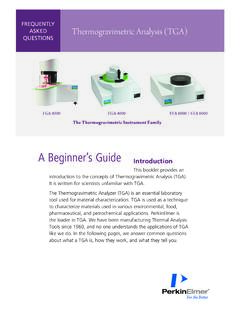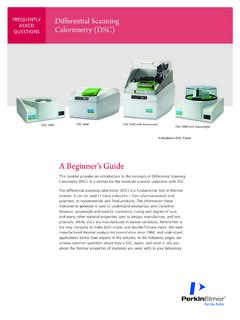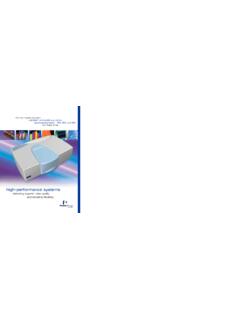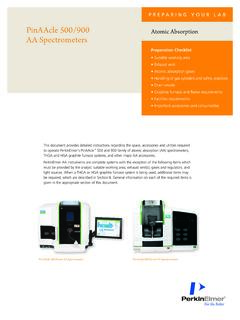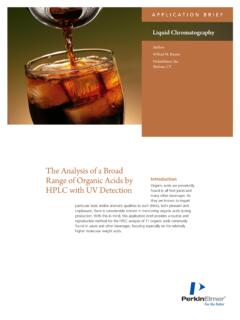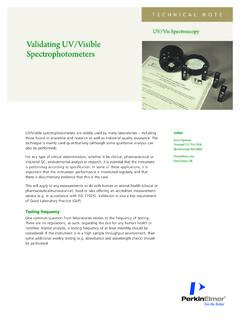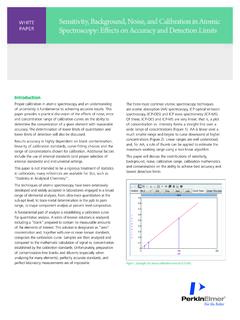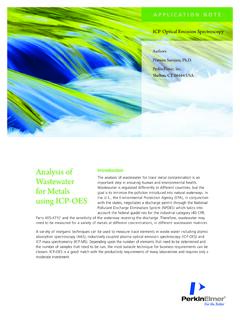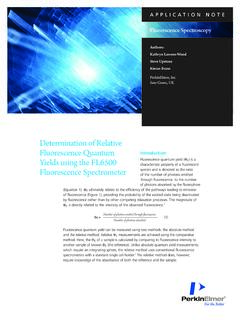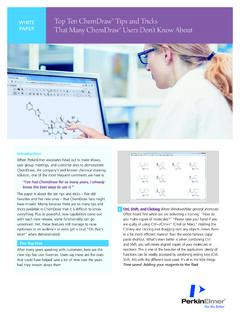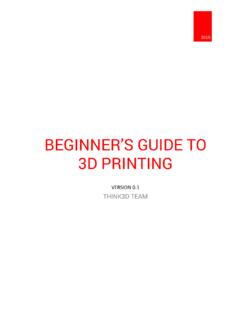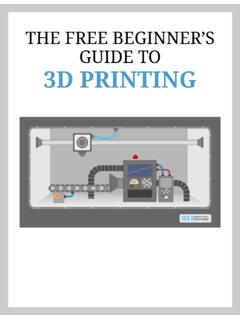Transcription of A Beginner’s Guide - PerkinElmer
1 FREQUENTLY ASKED QUESTIONSD ynamic Mechanical Analysis (DMA)A beginner s GuideThis booklet provides an introduction to the concepts of Dynamic Mechanical Analysis (DMA). It is written for the materials scientist unfamiliar with Mechanical Analysis (DMA) is a technique that is widely used to characterize a material s properties as a function of temperature, time, frequency, stress, atmosphere or a combination of these parameters. The DMA 8000 dynamic mechanical analyzer is one of the most flexible, cost-effective instruments available today. With a fully rotational sample compartment and accessories you can test samples by simulating real world scenarios easily and of Contents20 Common Questions about DMA 3 What is DMA? 3 How does DMA differ from Thermomechanical Analysis? 3 How does a DMA work? 3 What does DMA measure? 4 How does the storage modulus in a DMA run compare to Young s modulus?
2 4 What is damping? 4 Why would I want to scan modulus as a function of temperature? 5 How do I get good data? 5 How do I know what geometry to use? 6 How can I detect a Tg? 6 How do I know it s really a Tg? 7 Why does my Tg value sometimes not agree with my DSC value? 7 Can I do TMA in my DMA? 7 Can I use DMA to study curing? 8 Why should I be concerned about frequency scans and multiple frequency runs? 8 What does Time-Temperature Superposition (TTS) tell me? 8-9 How can I tell if a TTS is valid? 9 Why would I want to run my samples immersed in a fluid? 9 Can I use DMA to see if humidity affects my sample? 10Is UV curing an important application for my DMA if I have a photo-calorimeter? 10 Common Symbols in the DMA literature 11-12 Regions of Viscoelastic Behavior 12-13 DMA Glossary 13-21 What do the Changes in the Data Mean?
3 21-22 Further Readings 22-2323Q What is DMA?A Dynamic Mechanical Analysis, otherwise known as DMA, is a technique where a small deformation is applied to a sample in a cyclic manner. This allows the materials response to stress, temperature, frequency and other values to be studied. The term is also used to refer to the analyzer that performs the test. DMA is also called DMTA for Dynamic Mechanical Thermal How does DMA differ from Thermomechanical Analysis?A Thermomechanical Analysis, or TMA, applies a constant static force to a material and watches the material change as temperature or time varies. It reports dimensional changes. On the other hand, DMA applies an oscillatory force at a set frequency to the sample and reports changes in stiffness and damping. DMA data is used to obtain modulus information while TMA gives coefficient of thermal expansion, or CTE.
4 Both detect transitions, but DMA is much more sensitive. Some TMAs can do limited DMA and the PerkinElmer DMA 8000 is the only DMA that can do How does a DMA work?A DMA works by applying a sinusoidal deformation to a sample of known geometry. The sample can be subjected by a controlled stress or a controlled strain. For a known stress, the sample will then deform a certain amount. In DMA this is done sinusoidally. How much it deforms is related to its stiffness. A force motor is used to generate the sinusoidal wave and this is transmitted to the sample via a drive shaft. One concern has always been the compliance of this drive shaft and the affect of any stabilizing bearing to hold it in position. A schematic of the analytic train of the DMA 8000, Figure 1, shows its innovative design that requires neither springs nor air-bearings to support the drive Common Questions about DMAF igure 1.
5 Schematic of the DMA 8000 analytic What does DMA measure? A DMA measures stiffness and damping, these are reported as modulus and tan delta. Because we are applying a sinusoidal force, we can express the modulus as an in-phase component, the storage modulus, and an out of phase component, the loss modulus, see Figure 2. The storage modulus, either E or G , is the measure of the sample s elastic behavior. The ratio of the loss to the storage is the tan delta and is often called damping. It is a measure of the energy dissipation of a How does the storage modulus in a DMA run compare to Young s modulus?A While Young s modulus, which is calculated from the slope of the initial part of a stress-strain curve, is similar conceptually to the storage modulus, they are not the same. Just as shear, bulk and compressive moduli for a material will differ, Young s modulus will not have the same value as the storage What is damping?
6 A Damping is the dissipation of energy in a material under cyclic load. It is a measure of how well a material can get rid of energy and is reported as the tangent of the phase angle. It tells us how good a material will be at absorbing energy. It varies with the state of the material , its temperature, and with the 2. The relationship of the applied sinusoidal stress to strain is shown, with the resultant phase lag and Why would I want to scan modulus as a function of temperature?A Modulus values change with temperature and transitions in materials can be seen as changes in the E or tan delta curves. This includes not only the glass transition and the melt, but also other transitions that occur in the glassy or rubbery plateau, shown in Figure 3. These transitions indicate subtler changes in the material . The DMA 8000 s unique low starting temperature of -190 C in the standard furnace and of -196 C in the Fluid Bath let you easily look for these small molecular motions, Figure 3.
7 Figure 3. Modulus values change with temperature and transitions in materials can be seen as changes in the E or tan delta How do I get good data?A Good data requires several things: a properly calibrated instrument, a properly prepared specimen with a reasonable aspect ratio, using the right geometry, and applying both reasonable strains and heating rates. A properly calibrated instrument requires calibration for both temperature and force. A well prepared specimen should be of even thickness with parallel sides and right angle. Assuming the correct choice of geometry for the sample, a deformation of 50 microns and heating rates of 2-3 C/minute normally work How do I know what geometry to use?A The choice of the geometry you run your sample in is dictated by the sample s physical state at the beginning of the experiment, its difficulty in loading, and the experiment you want to run.
8 For example, a stiff bar of polymer can be run in all of the flexure fixtures, but single cantilever is often used because it is simple to load and allows thermal expansion of the specimen, shown in Figure 4. Uncured thermosets are often run in shear. The DMA 8000 not only has the a full range of fixtures covering the normal 3-point bending, single cantilever, dual cantilever, tension, compression and shear fixtures, but also offers the novel material Pocket for holding powders and soft samples that can not support their own weight. In addition, the design and flexible software make it possible to develop custom fixtures for your application. Ideal Heating/ Best Sample Preferred Geometry Sample Free Cooling Rate/ Choice Modulus/Pa (for indicated sample size)
9 Thickness/mm Length/mm C/min 1010 to 106 Tension < 2 5X 1010 to 105 Tension to 1 2 to 10 5X 1010 to 106 Single cantilever 1 to 2 5 to 10 3X 1010 to 106 Single cantilever 2 to 4 10 to 15 2 1010 to 106 Single cantilever >4 15 to 20 1X* 1010 to 106 Dual cantilever 2 to 4 10 to 15 2 *for highly orientated samples that are likely to retract above 1012 to 108 Three-point bending 1 to 3 10 to 20 3 1011 to 107 Three-point bending >4 15 to 20 2X 107 to 102 Simple shear to 2 5 to 10 (dia) 2 107 to 102 Compression (good for to 10 5 to 10 (dia) 2 irregularly shaped samples (height or thickness) and any others that are difficult to mount)width Generally sample width is uncritical and 5 mm is recommended (a wider sample may not be held uniformly in the clamps).
10 A smaller value should be used for stiff sample in tension (1 to 2 mm).Q How can I detect a Tg?A The glass transition (Tg) is seen as a large drop (a decade or more) in the storage modulus when viewed on a log scale against a linear temperature scale, shown in Figure 5. A concurrent peak in the tan delta is also seen. The value reported as the Tg varies with industry with the onset of the E drop, the peak of the tan delta, and the peak of the E curve being the most commonly 4. Preferred geometry for indicated sample How do I know it s really a Tg?A Running a multi-frequency scan and calculating the activation energy of the transition allows you to decide if the transition is really a Tg. The activation energy for a Tg is roughly 300-400 kJmol-1. In comparison a Tb has an activation energy of about 30-50 kJmol-1 and at the melt or Tm, the frequency dependency collapses.
